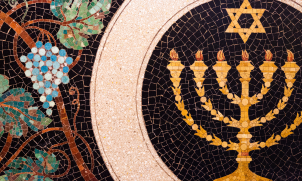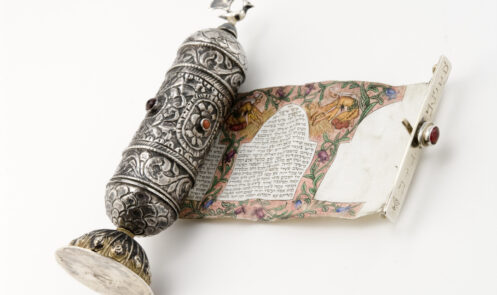Antisemitism, like any other kind of racism, is irrational
One of the most common questions asked by visitors at the Sydney Jewish Museum is “Why do some people hate Jewish people?”.
This question does not have a simple answer. Explaining the roots of antisemitism can be as challenging as addressing the reasons behind any form of hate, such as racism, misogyny, or homophobia. It’s crucial to avoid falling into the trap or rationalising or justifying these prejudices while trying to understand their origins.
Anti-Jewish hatred has a long history, going back thousands of years. It’s intertwined with a set of myths and lies, which have been used to scapegoat and blame Jewish people for such a long time, in so many societies around the world, that it has its own special name: antisemitism.
Antisemitism can be used to describe any act of prejudice against people for no other reason than the fact that they are Jewish. Despite this unique name, it is just plain and simply a form of racism. It can manifest in many ways, from overt acts of abuse – either physical, verbal, or psychological – to snide remarks or stereotypes based on deep-seated prejudices.
This resource, created by the team of expert educators and academics at the Sydney Jewish Museum, will provide a brief history of racism toward Jewish people, important terminology, and examples of how this pervasive type of hatred has existed both historically and today. It also offers teaching materials for schools, both primary and secondary classrooms, and recommend resources for further reading.
Our intention here is not just to educate you about the Holocaust. We have many other resources that do that. Rather, we want to help you understand the complexities of antisemitism and arm you with the tools to think critically. Our aim is to make Australia a better place by fighting against all kinds of racism: antisemitism or otherwise.
Racism towards Jewish people is widespread
In 2012, the American artist Mear One painted a mural titled Freedom for Humanity in London, depicting a group of hook-nosed bankers playing a game of Monopoly on the backs of people of colour. Many commentators have weighed in on the blatant antisemitic tropes perpetuated by the mural: the greedy Jewish businessmen creating financial capital at the expense of the world’s oppressed.
For many critics, what was more shocking than the mural’s obvious anti-Jewish racism was the fact it was dismissed or completely overlooked. There was a lack of response from politicians. British MP Jeremy Corbyn, for example, later apologised for his initial support for the artist and rejected the “production of antisemitic material of any kind,” but he had failed to recognise it when it was first exposed.
This episode is not unique. News reports of prominent individuals being called out for antisemitism are common, and these are often followed by apologies and claims of ignorance. This is not surprising. As you will read throughout this information hub, antisemitism has a long and dangerous history throughout the world.
In many cases, people accused of antisemitic behaviour tend to respond with shock or denial, not because they are trying to hide their own bigotry but because these tropes and stereotypes are so ingrained that people are often blind to their own prejudices.
Antisemitism is not specific to any political or ideological groups. It’s far more widespread. You can find it across the political spectrum, both right and left. It can also change to suit the context at hand, which is why Jewish people can be demonised as both Communists and Fascists at the same time.
The Holocaust is history’s worst example
Here at the Sydney Jewish Museum, everything we do works to combat racism. The Museum was founded in 1992 by Holocaust survivors, as a place of memory and education. Visiting us offers a unique opportunity to hear directly from survivors about the dangers of where prejudice toward any group of people can lead.
The Holocaust is the quintessential example of what can happen when racially motivated hatred is allowed to fester unchecked. It’s an event that happened around 80 years ago on the other side of the world. Yet, it had a major impact on the landscape of Australia’s Jewish community, and the broader Australian community, particularly in Sydney and Melbourne. In the years after the WWII, approximately 32,000 Holocaust survivors made new lives in Australia, making our nation home to the second largest proportion of Holocaust survivors to the overall population, after Israel.
After immense hardship and suffering, many survivors chose Australia because it was just so far away from Europe – the site of where so many members of their families were murdered, homes squandered and lives irreparably damaged. In coming to Australia, many thought they would be able to leave behind the hatred of the past and build a new life for themselves. Unfortunately, while far from Europe, Australia was not the refuge from the antisemitism rife in Europe and other parts of the world that survivors had hoped during the 1940s and 50s when they migrated here, and nor is it free from it today.
Antisemitism wasn’t invented by Nazis
The Holocaust is just one of many instances – though the most extreme and wide-scale – of severe anti-Jewish persecution that have taken place throughout history.
Many people think that anti-Jewish racism lived and died in Nazi Germany, but it has a history in many parts of the world, including here in Australia. In fact, anti-Jewish racism was so prevalent in Australia, that many turned their backs on Jewish people fleeing the Holocaust. In 1938, as Nazi persecution of German Jews was ramping up, Australia’s attitude towards Jewish refugees remained inhospitable. This was expressed at the Evian Conference on Refugees in July of 1938, by Australia’s chief delegate, Colonel T. W. White, who declared: “as we have no real racial problem, we are not desirous of importing one by encouraging any scheme of large-scale foreign migration”.
Sadly, antisemitism is alive and well in Australia today. The Executive Council of Australian Jewry highlights 495 reported incidents of anti-Jewish hatred occurring in Australia between October 2022 and September 2023.[1] These ranged from graffiti and posters, hate mail, vandalism, physical assault, and verbal abuse.
[1] Julie Nathan, Report on Antisemitism in Australia 2023: 1 October 2022 – 30 September 2023 (Edgecliff, NSW: Executive Council of Australia Jewry, 2024), https://www.ecaj.org.au/wordpress/wp-content/uploads/ECAJ-Antisemitism-Report-2023.pdf.


